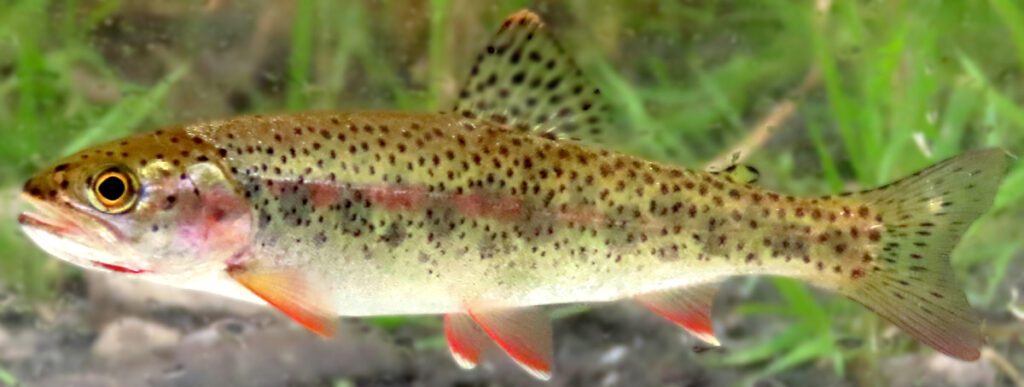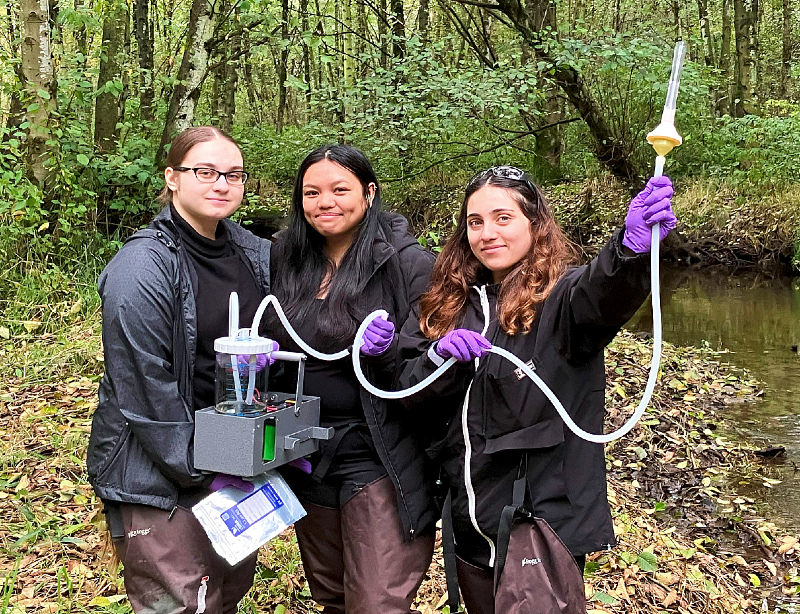Salmon on campus

UW Bothell: A river runs through it
One of UW Bothell’s many unique characteristics is a 58-acre restored wetland that includes North Creek, a salmon-bearing stream that hosts salmonids throughout the year and is an important spawning location in the fall.
Some salmon, like the Chinook salmon above, return to North Creek to spawn after completing a journey covering thousands of miles. Other species are more local, migrating only to Lake Washington to mature before spawning, and still others are homebodies that live in North Creek throughout the year. North Creek has had a challenging history of degradation due to farming, logging and urbanization — and the restoration of the UW Bothell wetland has provided much-needed habitat for salmon and the species that depend on them.
A complex ecosystem

In addition to salmon, of course, the UW Bothell wetland is home to a wide variety of species. Our year-round salmonid, coastal cutthroat trout, have proven to be remarkably resistant to the ill effects of urbanization. They are an important food source for predators, and they also benefit from the presence of beavers that create habitat by building ponds.
Adult salmon returning from their migrations are also an important food source for wetland inhabitants. Large salmon such as coho, Chinook and sockeye are consumed by otters, and smaller salmon such as kokanee are targeted by herons. The picture at left below shows a kokanee salmon with the characteristic triangular hole made by a heron. Otters often leave the remains of their meals along the sides of the stream (right). Salmon carcasses contribute nutrients to the wetland that make their way from bacteria to the largest mammal and the tallest tree.

Beavers and salmon
Overall, beavers are a benefit to salmon by supporting and extending the wetland, particularly for species like coho and Chinook that spend their juvenile period in the stream. Blockage of upstream migration, the issue that most often generates concerns about beaver dams and salmon, is rarely a problem. During periods of low water, salmon may be delayed or even stopped by a dam, but a good rain usually opens up avenues for salmon to pass. Salmon are both persistent and resourceful, as you can see in the videos below.
The “Little Red Fish”

When we think of salmon in the Lake Washington watershed, we usually think of the sockeye, Chinook and coho that pass through the Ballard locks every summer. A century ago, these fish were either absent or in low numbers. By far the most numerous salmon in the Lake Washington system were kokanee, a form of sockeye salmon that matures in lakes rather than oceans.
Biologists have historically divided these kokanee into three distinct populations: An “early run” in Issaquah creek, Lake Sammamish — declared extirpated in 2001; a “late run” in several other Lake Sammamish streams — this run is struggling; and a “middle run” spawning in small tributaries of Lake Washington and in the Sammamish River and tributaries.
This middle run was considered by most biologists to have been extirpated by the 1990s. Recent genetic and life history work done by UW Bothell faculty and students, in collaboration with the Washington Department of Fish and Wildlife and Trout Unlimited, has found evidence that the middle run survives. This is great news! Spawning occurs primarily in the Sammamish River in Woodinville and Bothell, and in the lower sections of North Creek including the UW Bothell wetland.
Salmon research collaborations

The presence of salmon on campus provides a great opportunity for collaborative research among faculty, students and members of the community. Since 2019, Professor Jeff Jensen (Division of Biological Sciences in the School of STEM) has managed the North Lake Washington Salmon Watchers program, modeled on a King County program that ran from 1995-2015. (Information and archived data can be found on King County’s Salmon Watcher Program page.)
Community members volunteer to observe a section of a local stream weekly and to submit observations on the Salmon Watchers website.
Information provided by citizen scientists is a valuable addition to work being done by UW Bothell students and faculty. Kokanee research is our primary focus. Our main tools are 1) field surveys by foot, camera and drone; 2) genetic analysis using both DNA sequencing of sampled tissue and analysis of environmental DNA (eDNA) collected in water samples; and 3) analysis of otoliths, great little nuggets of information in the inner ear of fishes that can reveal age and growth (like the rings of a tree) and migratory history.
Check the Salmon Watcher website for more information starting in August — and watch the video below for a sneak peek.
How to see salmon on and near campus
Most of the UW Bothell wetland is inaccessible to the public, but there is a boardwalk out to North Creek that can provide views of spawning salmon in season. At the end, look left and watch for swirls and fins in the smooth water above the riffle.
Salmon can also often be seen in North Creek from the trail under highway 522 and behind the Country Inn and Suites just upstream of I-405.
Interested in in-season updates about locations and numbers? Check out the North Lake Washington Salmon Watchers blog. For other locations to view salmon in the Seattle area check out the King County Salmon Season website.
Salmon, Lake Washington, and Lake Sammamish: Did you know?
- Before 1917, the outflow of Lake Washington was through the Black River in what is now Renton. The opening of the Lake Washington ship canal lowered Lake Washington by about 9 feet and dried up the Black River.
- Kokanee were once a very important source of food to Native Americans living along Lakes Washington and Sammamish, and along the Sammamish River. Kokanee are still very important culturally to the Snoqualmie Tribe. Check out this story map.
- You can see daily counts of sockeye coming through the Ballard locks at this Washington Department of Fish and Wildlife site.
- Pink salmon, not normally a part of the Lake Washington system, appear to have recently established themselves in Little Bear creek in Woodinville. Look for them in September 2025 as they only run on odd-numbered years in our area.
- Salmon share North Creek with many other species of fish, both native and non-native. Large scale suckers, pea mouth chub and long fin smelt migrate into the creek every spring. Sticklebacks are very common year around residents. These species are all native.
